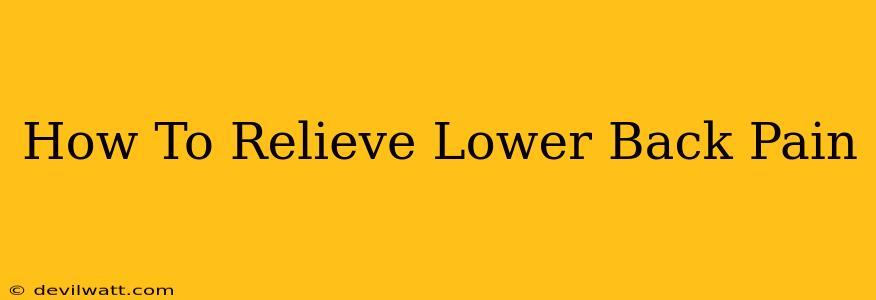Lower back pain is a common ailment affecting millions worldwide. It can stem from various causes, ranging from minor muscle strains to more serious conditions. This comprehensive guide explores effective ways to relieve lower back pain, empowering you to regain comfort and mobility.
Understanding Your Lower Back Pain
Before diving into solutions, it's crucial to understand the potential sources of your discomfort. Lower back pain can be acute (lasting less than six weeks), subacute (lasting six to twelve weeks), or chronic (lasting longer than twelve weeks). Possible causes include:
- Muscle strains or sprains: Often caused by lifting heavy objects improperly, twisting motions, or overuse.
- Disc problems: Herniated or bulging discs can put pressure on nerves, causing pain that radiates down the leg (sciatica).
- Spinal stenosis: Narrowing of the spinal canal puts pressure on the spinal cord and nerves.
- Osteoarthritis: Degenerative joint disease affecting the spine.
- Poor posture: Slouching or prolonged sitting can strain back muscles.
- Stress: Mental stress can exacerbate muscle tension and pain.
Effective Ways to Relieve Lower Back Pain
Fortunately, numerous strategies can help alleviate lower back pain. These methods can be used individually or in combination, depending on the severity and cause of your pain.
1. Over-the-Counter Pain Relief
Nonsteroidal anti-inflammatory drugs (NSAIDs) like ibuprofen or naproxen can help reduce inflammation and pain. Always follow the dosage instructions on the packaging. Acetaminophen (Tylenol) can also provide pain relief. Consult your doctor or pharmacist if you have any underlying health conditions before taking any medication.
2. Heat and Ice Therapy
Applying heat or ice can provide temporary relief. Heat helps relax muscles and increase blood flow, while ice reduces inflammation and numbs the area. Experiment with both to see which works best for you. Apply for 15-20 minutes at a time, several times a day.
3. Gentle Exercise and Stretching
Regular exercise is vital for strengthening back muscles and improving flexibility. However, it's important to choose low-impact exercises that don't exacerbate your pain. Examples include:
- Walking: A simple yet effective way to improve circulation and strengthen core muscles.
- Swimming: The buoyancy of water supports your body weight, reducing strain on your back.
- Yoga: Certain yoga poses can improve flexibility and strengthen back muscles. Focus on poses that don't cause pain.
- Pilates: Pilates focuses on core strengthening, improving posture and stability.
- Stretching: Gentle stretches like knee-to-chest stretches and cat-cow stretches can ease muscle tension.
4. Ergonomic Adjustments
Improper posture and workplace ergonomics contribute significantly to lower back pain. Make adjustments to your workspace to promote better posture:
- Adjust your chair: Ensure your chair provides adequate lumbar support.
- Position your computer screen: Keep the screen at eye level to avoid neck and back strain.
- Take frequent breaks: Get up and move around every 30-60 minutes.
- Lift properly: Bend your knees and use your legs when lifting heavy objects.
5. Mindfulness and Stress Management
Stress can significantly worsen back pain. Incorporate stress-reducing techniques into your daily routine:
- Deep breathing exercises: Practice deep, slow breathing to relax your body and mind.
- Meditation: Regular meditation can help reduce stress and improve overall well-being.
- Yoga: Beyond physical benefits, yoga incorporates mindfulness techniques that can reduce stress.
6. When to See a Doctor
While many cases of lower back pain resolve on their own, it's important to seek professional medical attention if:
- Your pain is severe or doesn't improve after a few weeks.
- You experience numbness, tingling, or weakness in your legs.
- You have bowel or bladder problems.
- You have a fever.
Preventing Future Lower Back Pain
Preventing lower back pain involves adopting healthy habits that promote strong back muscles and good posture. These include:
- Maintaining a healthy weight: Excess weight puts extra strain on your back.
- Regular exercise: Strengthening your core muscles is crucial for back support.
- Good posture: Pay attention to your posture throughout the day.
- Ergonomic workspace: Set up your workspace to avoid strain.
By following these tips and seeking professional help when needed, you can effectively manage and relieve lower back pain and improve your overall quality of life. Remember, consistency is key!

